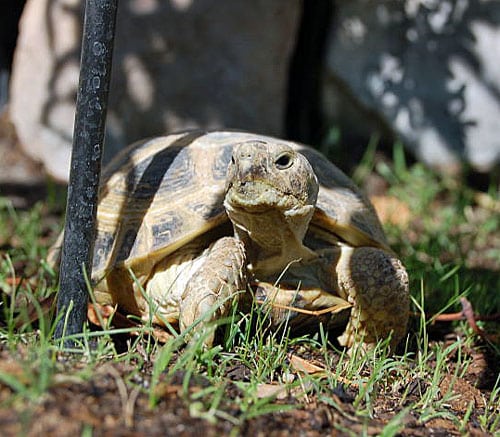Care sheet for the Russian tortoise Testudo Agrionemys horsfieldii
Russian Tortoise (Testudo [Agrionemys] horsfieldii)
A popular pet tortoise, Russian tortoises are one of the most readily available tortoise species. They are small, making them easy for most people with limited space to keep. They are also feisty, eager to eat and more active than some other tortoises. When allowed to burrow, Russian tortoises also have one of the highest tolerances for temperature extremes. They are one of the few species that can be kept outdoors in Las Vegas, Nev., year round. These factors make Russian tortoises attractive for new tortoisekeepers and a fun tortoise for seasoned veterans.
Russian Tortoise Availability
Most Russian tortoises are imported into the United States. Compared to the number of imported tortoises, captive production of this species is relatively low. You should assume that most adult or subadult Russian tortoises for sale are wild-caught (imported). Captive-bred babies are rarely raised to adult size and sold at the low prices that these imported Russian tortoises sell for.
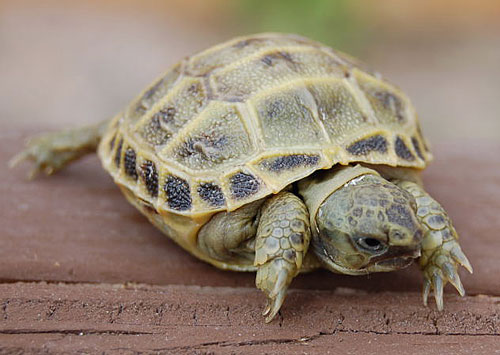
Photo Credit: Tyler Stewart
Russian tortoise hatchling.
Russian Tortoise Size
Russian tortoise hatchlings measure about 1 inch in carapace length. As they mature, they reach a maximum length of 8 to 10 inches. Females are normally a little larger than males at full size. When females are about 6 inches long, they are large enough to begin producing eggs. Russian tortoises are almost always imported as young adults between 4 and 5 inches in carapace length. These tortoises are large enough to handle subprime conditions during shipping but small enough to fit many in a fixed-size shipping crate. Russian tortoises larger than about 6 inches long can be difficult to find.
Russian Tortoise Life Span
Russian tortoises can live more than 40 years. Raised on a lean, high-fiber diet, captive-raised animals in low-stress environments have higher life expectancies.
Russian Tortoise Caging
The preferred method for raising Russian tortoises is an outdoor enclosure in a warmer climate. Pens for one or two adults should be at least 2 feet by 4 feet. Enclosure walls should be set into the ground 6 to 12 inches to prevent the tortoises from digging under the sides, and they should be 12 inches or higher aboveground.
Russian tortoises are burrowers. They tend to dig into corners and against objects. Placing large rocks under the soil in the corners helps prevent tortoises from digging out. In higher or lower temperatures, they attempt to go underground to insulate themselves from the extremes. Building Russian tortoises underground hide boxes that maintain more stable temperatures helps to keep them from burrowing too much. Shaded grassy areas that get regular water help to keep smaller tortoises cool.
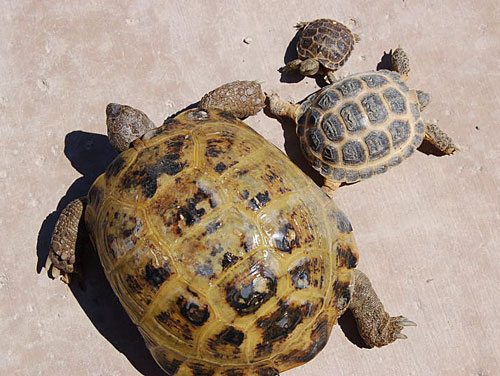
Photo Credit: Tyler Stewart
Russian tortoises hatchling to adult.
Russian tortoises are sure to try to eat any plant accessible to them in their pens. They prefer wide-leafed plants and weeds. They really do not eat grass unless they are out of options. Check all plants in the enclosure to ensure they are safe.
Russian tortoises housed indoors can be caged in large plastic bins, stock tanks or small plastic pools. One to two adults can be kept in an enclosure measuring at least 5 square feet, with sidewalls 8 inches or higher. More space is much better. Babies can get away with smaller housing. Tortoises kept in small enclosures become restless and spend much of the day trying to get out of the enclosures.
Many different substrates can be used. I prefer a combination of dirt or sand mixed with peat moss or fine coconut coir. Using only sand makes running around somewhat difficult for the tortoises. Their feet sink with every step. Mixing soils helps to solidify the foundation.
I also like to include a few large, flat rocks in an indoor enclosure. They help file down the tortoises’ nails and give them a clean surface for food. Russian tortoises also enjoy climbing, so try to provide an enclosure that gives them that opportunity.
Russian Tortoise Lighting and Temperature
Russian tortoises living outdoors and allowed to dig burrows are very capable of taking care of themselves as far as temperatures are concerned. I keep them outdoors in Las Vegas year round without additional heat sources. Winter lows are in the 20s (degrees Fahrenheit), and summer highs near 120 degrees.
Russian tortoises can handle high temperatures only if they can get underground where it’s cooler. Keeping any tortoise on an outdoor patio or anything aboveground when it’s over 100 degrees is too hot for them. Russian tortoises are most active when temperatures are between 60 and 90 degrees, but they remain active during the cooler parts of the day in midsummer, or they sleep underground in a burrow.
Russian tortoises hibernate underground during the winter if they are allowed some time to dig a burrow before cold temperatures set in. In Las Vegas, my tortoises bed down at various times during the fall and come out of hibernation in mid-February.
Indoors, Russian tortoises can be maintained at normal room temperatures: 68 to 80 degrees. They should also have access to an area heated by an overhead light. This spot should be in the 90- to 100-degree range. Like most diurnal, herbivorous reptiles, they need a UVB light in their indoor enclosures to help them properly process the calcium in their diets. These tortoises can handle nighttime temperatures into the low 50s without a problem.
Russian tortoises do not need to hibernate to be healthy, so tortoises kept indoors and maintained at stable temperatures will never skip a beat while winter winds below outside. Keep lights on 12 to 14 hours a day, and turn off all light and heat sources at night.
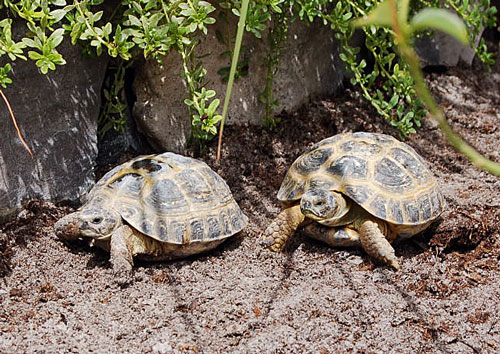
Photo Credit: Tyler Stewart
Russian tortoises hibernate underground during the winter if they are allowed some time to dig a burrow before cold temperatures set in.
Russian Tortoise Food
Russian tortoises are enthusiastic eaters, and the destruction they wreak on the plants in most outdoor enclosures is proof of this. They prefer broadleaf weeds and eagerly eat almost any leafy greens or vegetables offered to them. We regularly use spring mixes, which have several leafy ingredients in them. We supplement with kale, collared greens, turnip greens and any of the darker lettuce types. Variety is the key, and for their size, these tortoises do some serious eating.
I plant many different types of safe, leafy weeds in their outdoor enclosures in the spring. Dandelions are one of my favorite food sources for all tortoises. It might also be useful to partition off parts of the enclosure to allow plants to recover, and rotate the tortoises’ access to the separate areas. We also plant grasses, clovers and various other safe plants throughout the enclosure. If given full access to all available space, they will almost surely eat the plants down to nothing by midsummer.
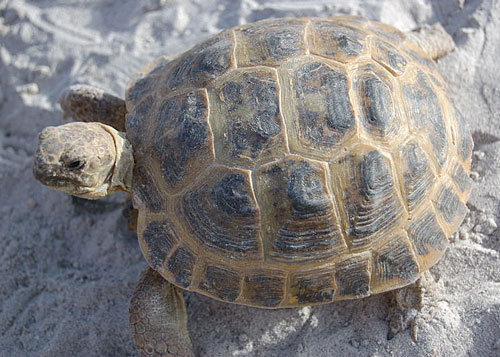
Photo Credit: Tyler Stewart
Russian tortoises should not be handled with any regularity. It is best to leave them alone.
Russian Tortoise Water
Russian tortoises can have small water dishes in their outdoor enclosures. We use shallow, low sided dishes that are glazed to make cleaning easy. Cleaning needs to be done on a regular basis, as most tortoises tend to soak in their dishes and “dirty” them while they’re in there. I provide water bowls during the hottest parts of the year, but I don’t during cooler times. Tortoises living in areas with regular rainfall drink from puddles and leaves. If they live in areas with prolonged dry periods, such as Las Vegas, offering them water helps to keep them hydrated.
When Russian tortoises are housed indoors, I prefer not to have standing water in the bowls because they tend to defecate in them while soaking. In shallow water, the tortoises usually begin drinking immediately and flush their systems at the same time. They can be soaked outside the enclosure in shallow water once or twice a week for 15 to 30 minutes to get them fully hydrated.
Babies and juveniles tend to dry out much quicker than larger, more established tortoises. Because of this, I briefly soak baby Russian tortoises in shallow water up to three times a week, for 10 to 15 minutes, whether they’re housed outdoors or indoors.
Russian Tortoise Health
For best results, purchase an alert, active Russian tortoise with bright, clean eyes, or buy one from a reputable source that will guarantee at least a live arrival. These tortoises can suffer from most common reptile health problems, but parasites and respiratory infections are probably the most common.
Although one of the more hardy tortoise species, wild-caught Russian tortoises usually have internal parasites. These parasites are not a huge burden on the animals in the wild, but when tortoises are confined to a small area and they endure the additional stresses of importation, the parasites can build up their numbers to levels potentially deadly to the tortoise. Taking a fresh fecal sample to a reptile veterinarian can get you some idea of the types of parasites present, their numbers and the drugs needed to treat them. Russian tortoises can also be prone to respiratory infections if they are kept in cool or wet enclosures. They need to be able to dry out, particularly if temperatures are low.
Russian Tortoise Handling and Temperament
Contrary to what many sellers tell customers, tortoises generally should not be handled with any regularity. They are easily stressed when overhandled, and children tend to drop them when spooked. These stress factors can lead to a decline in a tortoise’s activity levels and health. Adult Russian tortoises are generally more resistant to handling, but all tortoises should be handled carefully. Avoid pinning them down or restricting them. Allow them to carry on with their intended ways.
Tyler Stewart is the source for Russian Tortoise information. Please visit his site at www.TortoiseSupply.com.

